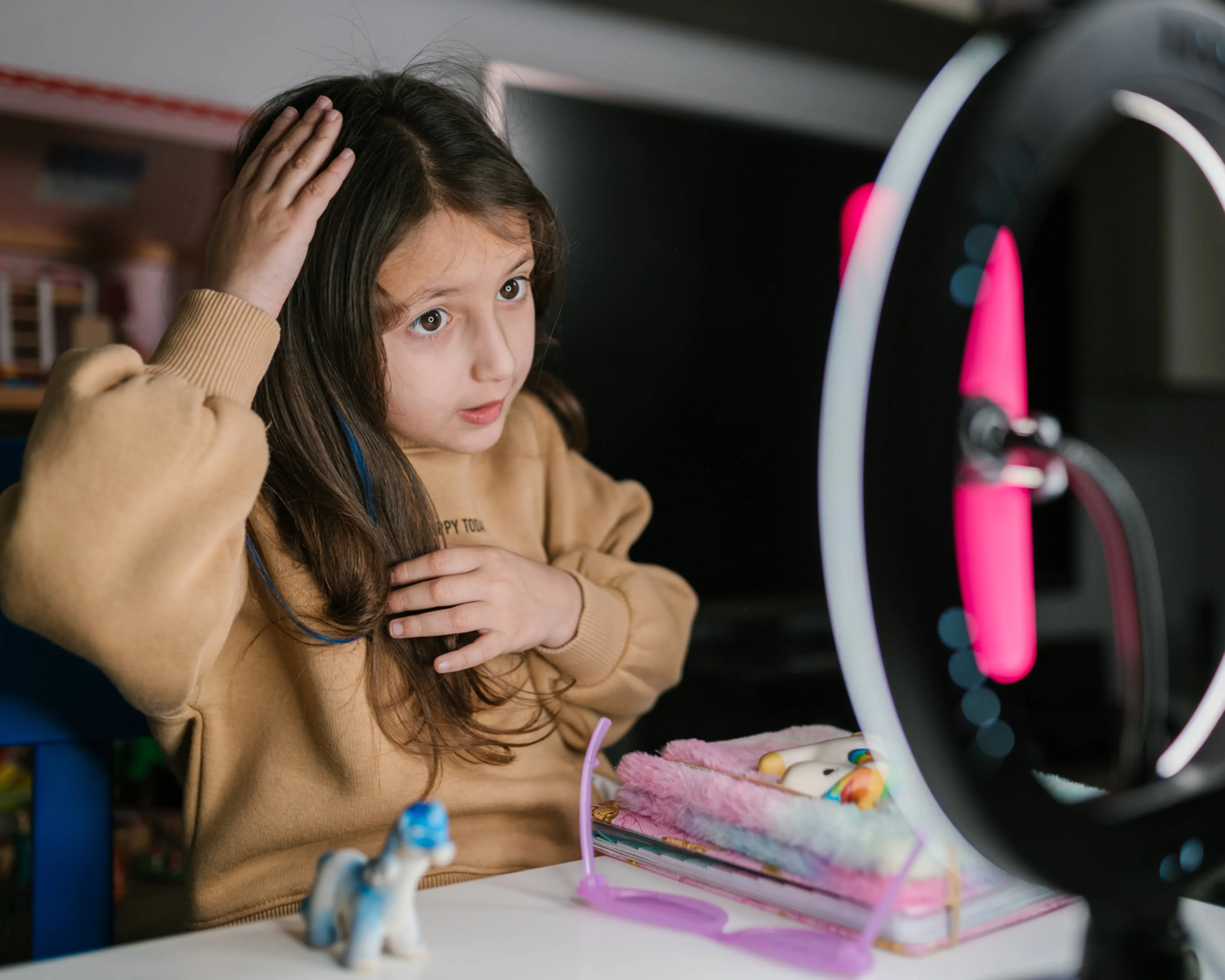The Staggering Impact of Social Media in Elementary Classrooms

By Katie Schuknecht
Updated on Mar 30, 2025

Originally designed for adults, social media platforms now influence children as young as seven and eight. 38 percent of children between the ages of eight and twelve have used social media, and almost one in five engage with it daily.
Research reveals that 20 percent of parents provide their child with a media device before age nine. A Common Sense Media study found that 68 percent of adolescent participants (ages 11 and 12) used social media, with TikTok (47 percent), Snapchat (31 percent), and Discord (25 percent) ranking as the most popular apps.
Social media use surged during the pandemic when people sought connectivity through various platforms to escape isolation. Today's elementary schoolers are growing up in a digital environment that fundamentally alters the course of their social, emotional, and academic development.
The impact is so severe that the US Surgeon General has asked policymakers to require warning labels on social media, similar to those on cigarette boxes and alcohol containers. Social media's influence on students’ lives creates challenges and opportunities that educators, parents, and policymakers must now address.

The Impact of Social Media on Academic Performance
Social media presents considerable challenges to elementary students’ academic development. While these platforms offer some benefits, documented decreases in academic performance and increased difficulty with focus overshadow the advantages.
Teachers must find balance as they learn how to help students navigate social media and the online landscape. Educational technology supports collaborative learning when educators use it thoughtfully, but it requires strategic guidance to limit the negative effects that social platforms have on young learners.

Social Media Presents Opportunities for Elementary Students
Research shows that moderate usage of digital devices by young students is linked to benefits, including more prosocial behaviors and fewer internalizing problems.
Another study reached similar conclusions, finding that moderate use of social media does not impact children’s life satisfaction. Constant exposure, however, results in lower happiness levels.
When adults properly supervise usage, social media platforms serve as practical learning environments for elementary students to develop essential digital literacy skills. They also function to maintain social connections among students, especially during extended periods of online learning.
Carol Vidal, child and adolescent psychiatrist at Johns Hopkins Children’s Center, asserts that social media can have a positive impact on young users. She shares, “Many children and teens may find a community that is more accepting of who they are and their identities than their immediate family or school environment. In that sense, social media can facilitate connection with peers who share interests, identities, and abilities.”

Social Media Poses Challenges for Elementary Students
Social media engagement significantly diminishes the foundational skills necessary for academic success.
Research demonstrates that the intensity of a student’s social media use correlates with decreased reading proficiency.
Even the mere presence of a smartphone reduces students’ memory learning and recall. Heavy Facebook users show lower gray matter density in the anterior cingulate cortex, an area of the brain involved in memory.
Young social media users may also experience higher test anxiety, further compromising their academic performance. Intense social media use is associated with low levels of school satisfaction and higher perceptions of school pressure.
While device distraction is often considered an issue reserved for middle and high school teachers, elementary classrooms face similar challenges. A 2024 Pew Research poll found that six percent of elementary school teachers identify cell phone distractions as a major classroom problem.
These academic downsides highlight the need for strategies that help elementary students navigate digital platforms while protecting their cognitive development.

The Effects of Social Media on Critical Thinking
Elementary school students are still developing critical thinking skills. Their young minds have not learned to separate fact from fiction or evaluate the credibility of a source.
Information Overload
Social media exposes students to an overwhelming volume of content, which significantly slows critical thinking development. This constant barrage of information makes it difficult for learners to understand the difference between essential and non-essential information.
This steady stream also creates an urgency to stay online and informed. Research shows that adolescents younger than 15 find it harder to disconnect from their smartphones than their older counterparts.
Reduced Attention Span
Social media's fast-paced, highly stimulating nature hinders students’ attention capabilities during traditional schoolwork.
48 percent of children aged zero to eight have watched short-form videos on social media platforms such as TikTok and Instagram, with 16 percent watching these videos daily. These videos average just 42.7 seconds in length, conditioning young minds to expect constant stimulation and rapid content transitions.
The consequence is students who struggle with delayed gratification and sustained effort. In one study, 24 percent of adolescent smartphone users reported struggling to concentrate during school activities.
Emotional Manipulation
Young social media users are susceptible to validation-seeking behaviors triggered by notifications. When children measure their self-worth through metrics such as likes and comments, they learn to make decisions based on social approval instead of independent reasoning.
Additionally, social media algorithms alter the content in real time based on user interactions while scrolling. These algorithms quickly create personalized echo chambers that limit viewpoint diversity and sometimes promote misinformation.
Frequent exposure to the same viewpoints prevents children from developing the cognitive flexibility they need to consider different perspectives.

Social Media, Elementary Classrooms, and Mental Health
Today, children use social media at younger ages than ever, and many teachers see the impact on children’s mental health. Students who use social media frequently tend to compare themselves to others, worry about their appearance, and struggle with sleep more than those who use social media less.
As elementary school students navigate online and in-person relationships, they lack the emotional tools to process their experiences. This creates teaching and learning challenges for everyone involved.
Cyberbullying
Social media allows personal disagreements to continue long after the end of the school day. Bullying was once limited to in-person interactions in school and on the bus, but today’s students can be plagued with classmate conflict even in the safety of their own homes.
The anonymity of the internet has also contributed to a rise in cyberbullying. Users feel comfortable sending messages that they would not say face-to-face.
Because they are still developing healthy coping mechanisms, younger adolescents are especially vulnerable to cyberbullying’s negative effects.
Students who experience online harassment often show declining academic performance and increased absenteeism. In addition, they are at an increased risk of mental health issues such as depression and suicide ideation.
Comparison to Others
Elementary students are highly susceptible to peer influence and social comparison during their formative years. The comparative nature of social media lends itself to a biased perception of other people.
Young social media users fail to recognize that most people on social media present an idealized version of their lives. As a result, they are quick to believe that the people they follow are happier, wealthier, smarter, or more attractive than themselves.
People who spend more time passively absorbing information from social media experience more intense levels of hopelessness, loneliness, and perceived inferiority. This distorted sense of reality can significantly impact students’ self-esteem and emotional well-being.
Sleep Disruptions
Because they lack self-regulation skills, elementary students may use social media late at night unless an adult sets external boundaries. Children ages six to twelve need at least nine hours of sleep a night; however, cell phone screens emit blue light that suppresses melatonin production, delaying sleep and disrupting circadian rhythms.
Nighttime social media use is associated with poorer sleep quality and higher levels of anxiety and depression. Students who use devices before bed often come to school tired and irritable, less able to practice emotional regulation.
Lack of sleep can have long-term mental health consequences for elementary students. Research from the National Institutes of Health found that children experiencing insufficient sleep showed reduced volume in brain regions responsible for inhibition control and memory even two years after the study.

Conclusion
Researchers are working to understand the long-term implications of social media exposure in elementary school. We currently know that social media's impact on elementary classrooms is not just concerning—it is staggering.
Today, younger students navigate psychological challenges that did not exist for high schoolers a generation ago. While the challenges associated with social media use are significant, they also present opportunities for innovation.
Experts emphasize that the greatest threat to a child’s safety is being provided with a smartphone but not the guidance and education about using it safely. Establishing healthy digital boundaries and teaching critical thinking skills early on allows educators to balance online connectivity with childhood well-being.
Parents, teachers, and administrators can take steps such as implementing media literacy programs, creating tech-free zones, facilitating open discussions about online experiences, and modeling healthy technology use.
By working together, school districts and caregivers can help elementary students develop the skills to navigate social media responsibly while protecting their academic success and mental health.